NVIDIA Tegra X1 Preview & Architecture Analysis
by Joshua Ho & Ryan Smith on January 5, 2015 1:00 AM EST- Posted in
- SoCs
- Arm
- Project Denver
- Mobile
- 20nm
- GPUs
- Tablets
- NVIDIA
- Cortex A57
- Tegra X1
Automotive: DRIVE CX and DRIVE PX
While NVIDIA has been a GPU company throughout the entire history of the company, they will be the first to tell you that they know they can’t remain strictly a GPU company forever, and that they must diversify themselves if they are to survive over the long run. The result of this need has been a focus by NVIDIA over the last half-decade or so on offering a wider range of hardware and even software. Tegra SoCs in turn have been a big part of that plan so far, but NVIDIA of recent years has become increasingly discontent as a pure hardware provider, leading to the company branching out in unusual ways and not just focusing on selling hardware, but selling buyers on whole solutions or experiences. GRID, Gameworks, and NVIDIA’s Visual Computing Appliances have all be part of this branching out process.
Meanwhile with unabashed car enthusiast Jen-Hsun Huang at the helm of NVIDIA, it’s slightly less than coincidental that the company has also been branching out in to automotive technology as well. Though still an early field for NVIDIA, the company’s Tegra sales for automotive purposes have otherwise been a bright spot in the larger struggles Tegra has faced. And now amidst the backdrop of CES 2015 the company is taking their next step into automotive technology by expanding beyond just selling Tegras to automobile manufacturers, and into selling manufacturers complete automotive solutions. To this end, NVIDIA is announcing two new automotive platforms, NVIDIA DRIVE CX and DRIVE PX.
DRIVE CX is NVIDIA’s in-car computing platform, which is designed to power in-car entertainment, navigation, and instrument clusters. While it may seem a bit odd to use a mobile SoC for such an application, Tesla Motors has shown that this is more than viable.
With NVIDIA’s DRIVE CX, automotive OEMs have a Tegra X1 in a board that provides support for Bluetooth, modems, audio systems, cameras, and other interfaces needed to integrate such an SoC into a car. This makes it possible to drive up to 16.6MP of display resolution, which would be around two 4K displays or eight 1080p displays. However, each DRIVE CX module can only drive three displays. In press photos, it appears that this platform also has a fan which is likely necessary to enable Tegra X1 to run continuously at maximum performance without throttling.
NVIDIA showed off some examples of where DRIVE CX would improve over existing car computing systems in the form of advanced 3D rendering for navigation to better convey information, and 3D instrument clusters which are said to better match cars with premium design. Although the latter is a bit gimmicky, it does seem like DRIVE CX has a strong selling point in the form of providing an in-car computing platform with a large amount of compute while driving down the time and cost spent developing such a platform.
While DRIVE CX seems to be a logical application of a mobile SoC, DRIVE PX puts mobile SoCs in car autopilot applications. To do this, the DRIVE PX platform uses two Tegra X1 SoCs to support up to twelve cameras with aggregate bandwidth of 1300 megapixels per second. This means that it’s possible to have all twelve cameras capturing 1080p video at around 60 FPS or 720p video at 120 FPS. NVIDIA has also made most of the software stack needed for autopilot applications already, so there would be comparatively much less time and cost needed to implement features such as surround vision, auto-valet parking, and advanced driver assistance.
In the case of surround vision, DRIVE PX is said to deliver a better experience by improving stitching of video to reduce visual artifacts and compensate for varying lighting conditions.
The valet parking feature seems to build upon this surround vision system, as it uses cameras to build a 3D representation of the parking lot along with feature detection to drive through a garage looking for a valid parking spot (no handicap logo, parking lines present, etc) and then autonomously parks the car once a valid spot is found.
NVIDIA has also developed an auto-valet simulator system with five GTX 980 GPUs to make it possible for OEMs to rapidly develop self-parking algorithms.
The final feature of DRIVE PX, advanced driver assistance, is possibly the most computationally intensive out of all three of the previously discussed features. In order to deliver a truly useful driver assistance system, NVIDIA has leveraged neural network technologies which allow for object recognition with extremely high accuracy.
While we won’t dive into deep detail on how such neural networks work, in essence a neural network is composed of perceptrons, which are analogous to neurons. These perceptrons receive various inputs, then given certain stimulus levels for each input the perceptron returns a Boolean (true or false). By combining perceptrons to form a network, it becomes possible to teach a neural network to recognize objects in a useful manner. It’s also important to note that such neural networks are easily parallelized, which means that GPU performance can dramatically improve performance of such neural networks. For example, DRIVE PX would be able to detect if a traffic light is red, whether there is an ambulance with sirens on or off, whether a pedestrian is distracted or aware of traffic, and the content of various road signs. Such neural networks would also be able to detect such objects even if they are occluded by other objects, or if there are differing light conditions or viewpoints.
While honing such a system would take millions of test images to reach high accuracy levels, NVIDIA is leveraging Tesla in the cloud for training neural networks that are then loaded into DRIVE PX instead of local training. In addition, failed identifications are logged and uploaded to the cloud in order to further improve the neural network. Both of these updates can be done either over the air or at service time, which should mean that driver assistance will improve with time. It isn’t a far leap to see how such technology could also be leveraged in self-driving cars as well.
Overall, NVIDIA seems to be planning for the DRIVE platforms to be ready next quarter, and production systems to be ready for 2016. This should mean that it's possible for vehicles launching in 2016 to have some sort of DRIVE system present, although it's possible that it would take until 2017 to see this happen.



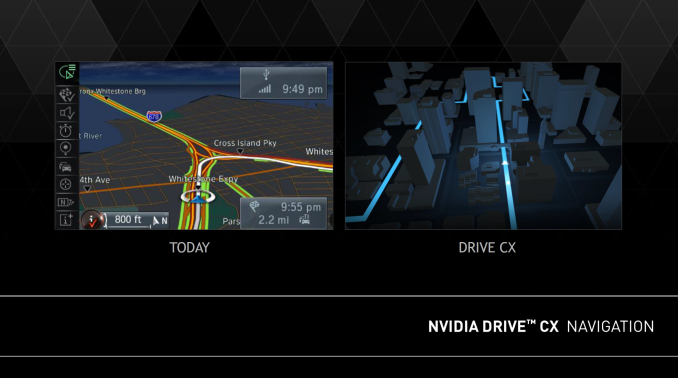
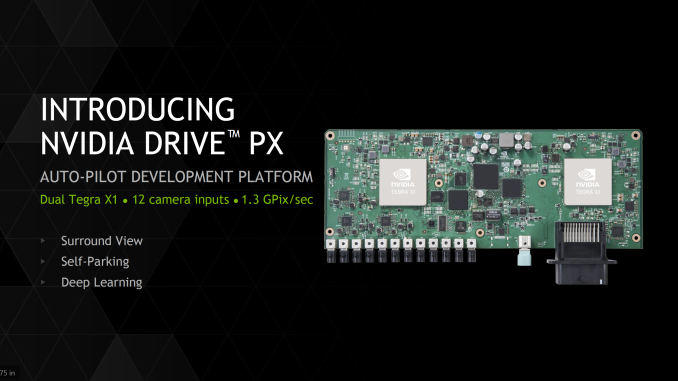
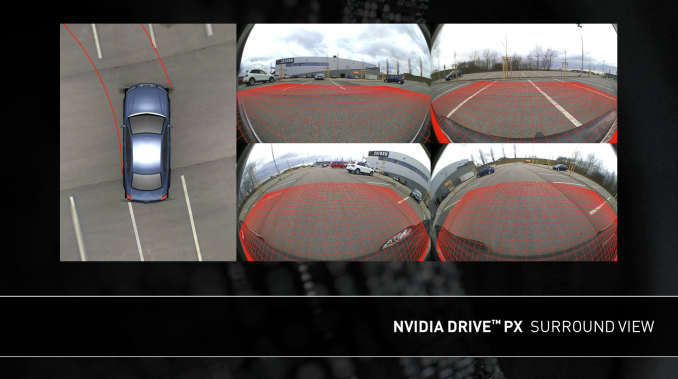

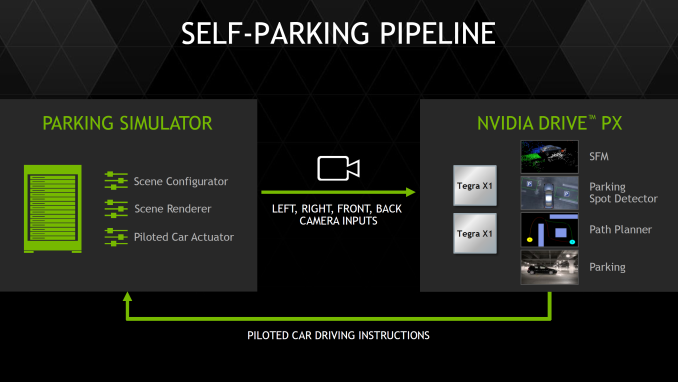


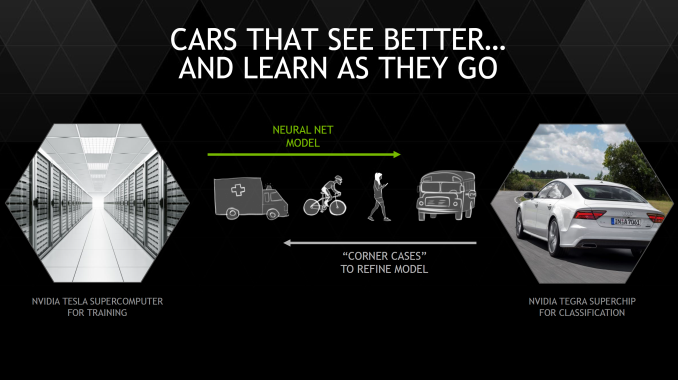
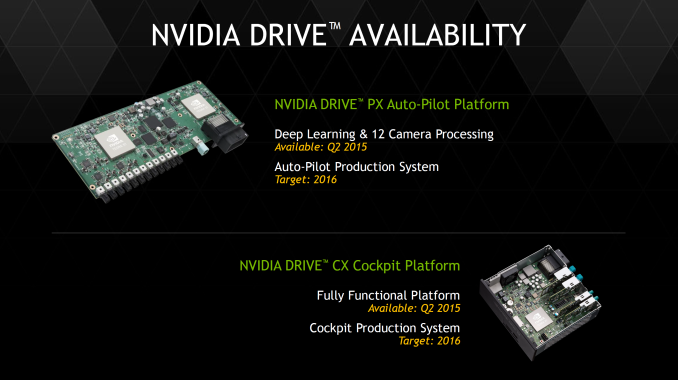








194 Comments
View All Comments
Yojimbo - Monday, January 5, 2015 - link
I can imagine that NVIDIA might release a Denver-and-updated-Maxwell-powered SOC in 2016 and if Denver is successful then a Pascal-and-Denver-powered SOC in 2017. ??? Unless NVIDIA is able to improve their execution well enough to release a Pascal-powered SOC in time for next year. That last possibility seems a bit far-fetched considering their history in the segment, though.jjj - Monday, January 5, 2015 - link
Actually the high end SoC market won't be competitive since only Qualcomm has integrated modem.Guess 4 Denver cores was not doable on 20nm (die size or clocks) and that's disappointing, was really looking forward to more big cores. If they can get the CPU perf they claim, it's not bad but they might have a small window before 16nm shows up.
Seems another lost year in mobile for Nvidia, if they even care about it anymore, not so sure they do.
A quad Denver in high end, a dual for midrange and glasses, ofc both with integrated modem and maybe they would have been relevant again.
Krysto - Monday, January 5, 2015 - link
Strange that Nvidia still hasn't made big strides with its "soft-modem" that was supposed to easily support multiple bands at once.Yojimbo - Monday, January 5, 2015 - link
The soft-modem thing didn't seem to work out the way they had hoped. They seem to have given up trying to compete with Qualcomm in the smartphone market. The OEMs don't like the soft-modem and don't Iike a separate modem chip. NVIDIA's SOCs just don't differentiate themselves significantly enough from Qualcomm's that the OEMs are willing to accept one of those two things. Plus Samsung controls most of the Android smartphone market and seems to be very comfortable with their supplier system. I bet frustration about that on the part of NVIDIA is probably partially what led to the patent lawsuit. In any case, I wonder what NVIDIA is doing with Icera currently... if they are trying to sell it, or what.PC Perv - Monday, January 5, 2015 - link
Not that I think Denver is great or terrible or anything, but modems are not very important on tablets because number of 4G tablets are a fraction of WiFi ones.darkich - Monday, January 5, 2015 - link
Do you people finally see now just how PATHETIC Intel Core M is??Its top of the line chip, done on way superior process, costs $270, has a GPU that manages around 300GFLOPS, while this here 20nm chip that will sell for well under $100, reaches over 1 TERAFLOP!!
And the yearly doubling of the mobile GPU power continues.
Seems like in 2016 we could see small tablets that will be graphically more capable than Xbox one
Krysto - Monday, January 5, 2015 - link
No disagreement there. Broadwell is a dud (weak update to Haswell) and Broadwel-Y/Core M is a scam that will trick users into buying low-performance expensive chips.kron123456789 - Monday, January 5, 2015 - link
"Seems like in 2016 we could see small tablets that will be graphically more capable than Xbox one" - I don't think that even Nvidia can make the SoC with roughly 3x more performance than Tegra X1 within one year. Maybe in 2017-2018?darkich - Monday, January 5, 2015 - link
Well according to raw output, X1 is already close to Xbone (1TFLOPS vs 1.35TFLOPS)Assuming that Nvidia doubles it again next year, even PS4 could be within reach
TheFlyingSquirrel - Monday, January 5, 2015 - link
The 1TFLOPS of the X1 is for FP16. The 1.35 of the Xbox One is FP32. The FP32 performance of teh X1 as stated in the article is 512GFLOPS.